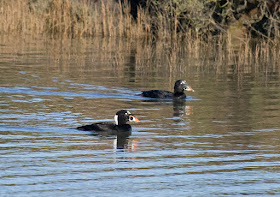 |
| Getting my ducks in a row (okay, fine, geese). Front three geese, left to right: Taverner's Cackling Goose, Aleutian Cackling Goose, Western Canada Goose. Ramona, San Diego County, California. February 1, 2015. Greg Gillson. |
[Click all photos for larger view.]
While observing the large goose flock on Rangeland Road, near Ramona, California, last week I found and photographed the previously reported Snow Goose, two Greater White-fronted Geese, and 4 Cackling Geese.
Not one to leave well-enough alone, I observed that of the four Cackling Geese present, only one was the expected Aleutian form with dark breast and wide white neck ring at the bottom of the black neck stocking.
It has been 11 years now since the AOU split the white-cheeked geese formerly known only as "Canada Goose" into Canada and Cackling geese. In western Oregon I was used to commonly seeing 3 types of Cackling Geese and up to 4 types of Canada Geese, fall through spring. It just so happens that Aleutian Cackling Goose is the rarest of the 3 types of Cackling Geese I would see in Oregon. It is, however, the only expected form in San Diego County.
As a former eBird Reviewer, I was a bit sensitive about correctly reporting Canada and Cackling Geese, writing one blog post about it (for instance, check out: "
Greg's white-cheeked goose rant--I mean, primer").
I will admit that only a few birders care about various races (subspecies) of geese. But think about this: Goose hunters, shooting at dawn on dark, foggy mornings--without binoculars--are expected to shoot only the allowable subspecies of geese. If not, they can be fined. I'm sure, if you wanted to, with your binoculars and spotting scope, you could correctly identify the various races of white-cheeked geese better than these hunters, couldn't you?
For southern California, south of the Central Valley, only the Western Canada Goose (
Branta canadensis moffitti, also known as Great Basin Canada Goose or Moffitt's Canada Goose) and Aleutian Cackling Goose (
Branta hutchinsii leucopareia) are expected in winter.
Which brings us back to last week's birds. Below is another photo of the three forms in question. The big Western Canada Goose is on the right and all around behind. Large size, pale breast, long bill, long neck.
In the center is the Aleutian Cackling Goose. Small size, dark breast, square head, tiny triangle bill, wide white collar at bottom of black neck stocking.
On the left is another Cackling Goose. It is slightly larger than the Aleutian, but still only 1/2 the size of the big Western's. And look at that silvery breast! Ridgway's (
B.h.minima) is the smallest and darkest breasted. This is not that subspecies. That leaves the smaller and square headed Richardson's (
B.h. hutchinsii) of the East and larger Taverner's (
B.h. taverneri) of the West with more sloping forehead. Everything points to these pale breasted Cackling Geese as being Taverner's.
 |
| Another view. |
Here are two more Cackling Geese, below. The bird on the left is slightly larger, paler, and thicker-necked than the bird on the right. The left bird is definitely Taverner's. The right bird shows some attributes tending toward Ridgway's (smaller size, slightly darker back, frosted wing covert stripes) but has the head of Taverner's (shallower forehead, rounder, crown, less stubby bill). Plus, the breast on the right bird is not purplish-brown as Ridgway's. So, I'm calling both these birds Taverner's Cackling Geese. (But I could be talked out of making any definite subspecies identification of the right Cackling Goose--intergrades are known.) [
Update: 1/19/2018: I have recently heard (though not confirmed) that first-year Aleutian Cackling Geese may lack the darker breast and white neck ring. If true, the slightly smaller and darker bird below on the right may be Aleutian.]
 |
| Two Taverner's Cackling Geese amid Moffitt's Canada Geese. Ramona, California. February 1, 2015. Greg Gillson. |
Note that the wing tips extend past the end of the tail on the Cackling Geese, while the wing tips fall short of the end of the tail on the Canada Geese. Lesser Canada Goose (
Branta canadensis parvipes) may be the size and color of Taverner's Cackling Goose, but has the short wings of Canada Goose. Thus, that left bird is a Cackling Goose and not one of the smaller subspecies of Canada Goose.
























